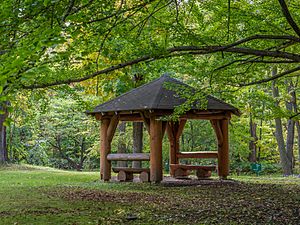Pavilion facts for kids
In architecture, a pavilion is a special kind of building. It can be a smaller building that stands on its own, or it can be a part of a bigger building. Pavilions are often built for fun, relaxation, or to enjoy a nice view.
In large palaces, especially in Asia, you might find many pavilions. They can be separate buildings or connected by covered walkways. Famous examples include the Forbidden City in China and the Topkapı Palace in Istanbul. In places like the Red Fort in India, pavilions are also a key part of the design.
Sometimes, pavilions are like "bookends" for a big palace. They are building sections placed equally on both sides of a main building. This makes the whole structure look balanced and grand.
The word "pavilion" comes from the French word pavillon. This word originally came from the Latin word papilio, which meant "butterfly." In older times, it also meant "tent." This is because the fabric of a tent looked a bit like a butterfly's open wings!
Contents
Free-standing Pavilions
Many pavilions are small buildings in a garden. They are like a summer house or a kiosk. People used to build these a lot up until the 1700s. They were sometimes called casina in Italian, which is where the word "casino" comes from! These small buildings often looked like tiny classical temples.
If a pavilion has space to prepare food, it might be called a banqueting house. If it's built to give you a great view, it's often called a gazebo. Even Bandstands in parks are a type of pavilion where musicians play. A nice poolhouse by a pool can also be called a pavilion.
Some free-standing pavilions are very large, like the Royal Pavilion in Brighton, England. This building is actually a huge palace built in an Indian style. But like smaller pavilions, it was made for enjoyment and relaxing.
Sports Pavilions
A sports pavilion is usually a building next to a sports field. It's used by players to change clothes and often to get refreshments. Many have a verandah (a covered porch) to protect spectators from the sun.
In cricket grounds, like at Lord's, the building where players come out from and go back into is called a cricket pavilion. This can be a very large building, even one with a grandstand (a big seating area). In baseball parks, a pavilion is a covered seating area, usually with one level.
Pavilions in Classical Architecture
In classical buildings, pavilions can be made to stand out in many ways. They might be taller, have a different shape, or be made of different materials. They can also have special colors or decorations. Inside, they might be part of a rectangular building or connected to the main part by a thin section.
For example, Houghton Hall and Holkham Hall in England show different ways pavilions were used in the 1700s.
In Paris, France, the Place des Vosges (built 1605–1612) has two special pavilions. They are called the Pavillon du Roi (King's Pavilion) and the Pavillon de la Reine (Queen's Pavilion). Even though no king or queen ever lived there, these pavilions act like grand gatehouses. They let people enter the special square.
Other Uses of Pavilions
Sometimes, a pavilion is a term for a hunting lodge. For example, the Pavillon de Galon in Luberon, France, is a typical hunting pavilion from the 1700s. It was built on the site of an old Roman villa and had a beautiful French-style garden. Guests used this garden for parties and gatherings.
Gallery
-
Küçüksu Pavilion in Istanbul, Turkey
-
The front of Houghton Hall ends with a pavilion on each side.
-
A plan of Holkham Hall. Here, a thin section connects the pavilions to the main building.
-
Pavilions at each end of the Upper Belvedere in Vienna.
-
The white marble Naulakha Pavilion at the Lahore Fort, Pakistan.
-
A banqueting house at Studley Royal Park.
-
The Dianatempel (1613–1617) in the Hofgarten, Bavaria.
-
Ahmad Shahi Pavilion, part of the Niavaran Palace Complex, Tehran (1800s).
-
Abdur Rahman Khan's garden house inside the royal Arg Palace, Kabul (1800s).
-
A poolhouse at Edgewater in Barrytown, New York, United States (1998).
-
A bandstand (Musikpavillon) at Bürkliplatz in Zurich, Switzerland (1908).
-
Ridge pavilion in Heinola, Päijänne Tavastia, Finland.
-
A stone pavilion, Indian Springs State Park, Georgia.
-
A marble pavilion, Red Fort, Delhi.
See also
 In Spanish: Pabellón (arquitectura) para niños
In Spanish: Pabellón (arquitectura) para niños





















